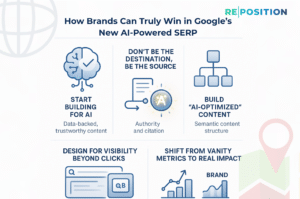The game has changed, and that’s a good thing.
For years, SEO has been a battle of position and pixels. Brands fought for blue links, meta descriptions, and rich snippets. But now, Google’s AI-generated overviews are rewriting the rules. Summaries powered by algorithms sit at the top, feeding users instant answers without a single click.
Here’s the truth: You don’t need to fear the loss of clicks. You need to rethink your values.

How Brands Can Truly Win in Google’s New AI-Powered SERP
AI-generated overviews aren’t guessing. They’re summarizing insights from authoritative sources, pulling from top-tier content to answer queries with confidence.
So the question is: Is your content something an AI would trust?
Start creating content that isn’t SEO fluff. That means:
If your content can teach the AI, it will surface in the AI.
Forget chasing traffic like it’s 2015. Focus on becoming the reference. When Google’s AI pulls together an overview, it draws from high-trust sources.
That means:
Brand influence now outweighs brand visibility.
AI overviews aren’t driven by keywords. They’re driven by context and clarity. So your next content pieces should be structured for semantic depth.
How?
This isn’t keyword stuffing, it’s knowledge architecture.
Traffic may go down, but brand recall can go up. That’s where smart design comes in:
You’re no longer just a website. You’re a knowledge node in the AI-driven web.
If you’re still obsessed with traffic numbers, you’re playing the wrong game. Shift your KPIs:
You’re not losing traffic. You’re gaining influence.
Google’s AI overviews are not a death sentence for content marketers, they’re a quality filter. The lazy content dies. The valuable content gets promoted even if it isn’t clicked.
Brands that adapt won’t just survive. They’ll become the sources everyone else gets summarized from.
So stop chasing clicks. Start owning the conversation.